What’s in Your Shed? visits a Cornish dairy farm
 Andrew Carbis (centre), Tom Rule, parents Michael and Rachel, and daughter Lerryn © James Andrews
Andrew Carbis (centre), Tom Rule, parents Michael and Rachel, and daughter Lerryn © James Andrews A hoard of ingenious home-made kit and a clutch of noughties Massey Fergusons are just some of the treasures hiding in the sheds of Cornish dairy farmer Andrew Carbis.
It’s a forage wagon, however, that tops the list as his favourite. We find out more.
See also: Driver’s view: Massey Ferguson 5S.135 Dyna-4 tractor
Farm facts
- Farm size 160ha, 127ha of which is owned
- Cows 200 British Friesians plus followers
- Other enterprises Beef herd and holiday cottages
- Run by Andrew, his wife Sarah and parents Michael and Rachel
- Staff Tom Rule and part-time relief milker Robert Dingle
Are you brand loyal?
All our tractors are Massey Ferguson these days, apart from the old Ford 4600.
They’re nice to drive, good value for money and pretty reliable.
Plus, we’ve got a great independent mechanic, Chris Wasley, on our doorstep who helps us keep them running.
We’ve got plenty of them, which means we can have multiple implements hooked up at once.
This comes in particularly handy when flitting between jobs such as silage making and feeding, as we don’t have to swap implements umpteen times a day.
Other equipment is bought based on its reputation and value for money, rather than the brand.
And if we can find a way to make something cheaper ourselves, we’ll do that instead.
Favourite dealer?
As most of our kit is second-hand or home-made, we don’t have that much to do with main dealers.
The majority of our spare parts and used machinery comes from Peter Hawkey Farm Machinery.
But when we do buy the odd piece of new kit, we tend to gravitate towards Halse of Honiton.
It always has plenty of equipment in stock and the prices are pretty competitive – if we were any closer it could be dangerous for our bank balance.
Favourite piece of kit?
That would be our Strautmann Giga Vitesse 3601 forage wagon, which has become invaluable.
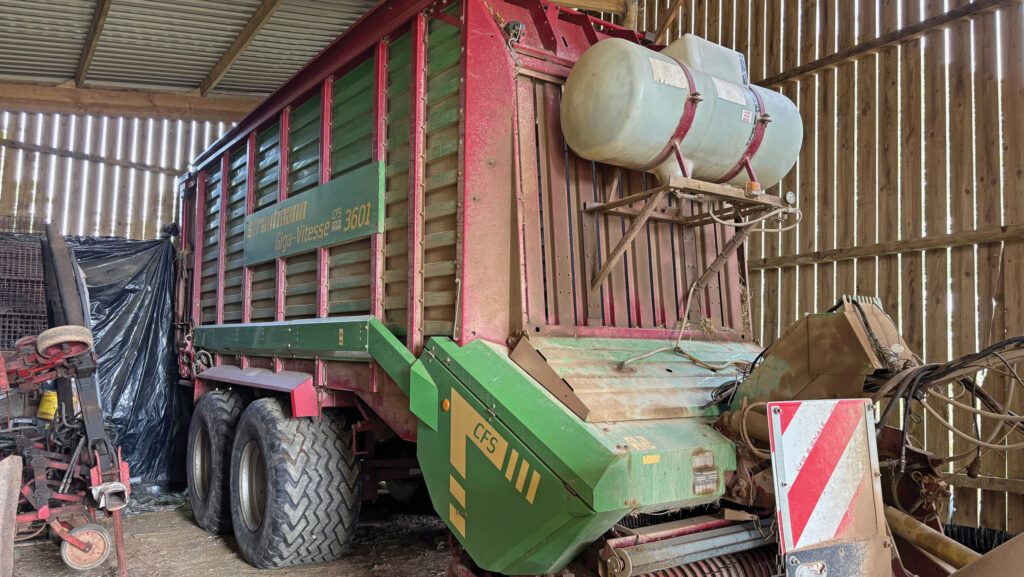
© James Andrews
As well as saving a fortune getting a contractor in with a self-propelled, it allows us to do a bit as and when we want.
We also lift some grass for a couple of neighbouring farmers.
The longer chop length isn’t a problem for us and, although it takes a bit more time to build the clamp, we’ve never had any issues with quality. Fuel use is respectable too.
When measured over 70ha of chopping, the tractor used 500 litres, including hauling to the clamp.
We had our first ex-demonstrator model nine years ago, but it was destroyed in a farm fire so we replaced it with this one, which had also done very little work.
It’s run with two sets of knives and we have a sharpening tool to make sure there’s always a good edge on them.
And your least favourite?
A couple of things spring to mind, both of which have been moved on.
One is a Lemken Smaragd stubble cultivator that was terrible for hooking trash and always left an uneven finish.
The other is a West Dual spreader that rusted like an anchor and had a very uneven spread pattern.
We always ended up going over fields twice to get decent coverage.
Latest purchase?
We recently bought a new galvanised Major 3100gal tanker to replace an old Slurry Guzzler, and upgraded our hedgecutter.
After shopping around for decent second-hand models, we concluded that new ones were the best value.
Why spend £18,000 on a machine that might be OK if you can buy an unused one for £25,000?
For that we got a McConnel PA6070 with 1.6m head and roller, plus a joystick controller.
We opted against adding an orbital unit, which saved some cash and meant there was one less thing to wear out.
Around the same time, we bought a Wakely 0830 roller mill, which has virtually removed the need to buy in processed feeds.
Together with a slightly modified old Keenan and feed bin blower system, we can produce parlour and youngstock mixes by just adding protein pellets and molasses.

© James Andrews
At £25,000, it was too big an investment for just our work, but we were also asked to mill for another local farmer, which meant the figures stacked up fairly well.
Oldest machine still at work?
That’s our 1979 Ford 4600 scraper tractor. It came here when it was two years old and we reckon it has done about 11,000 hours – it’s hard to tell exactly as the clock isn’t the most reliable.

© James Andrews
It’s had two replacement engine blocks in its time, the first going in spectacular fashion when a con rod shot through the side while driving down the road.
The second went porous, but the current one has been in for about 10 years and is still going strong.
Other than that, it’s been a reliable tool and will hopefully continue to be.
Rust has got the better of the cab, which is largely held together with sheets of Perspex, bits of blue plastic barrel and tek screws, but it’s still mechanically sound.
In fact, it’s just been treated to new kingpin bushes and front wheels, a full set of tyres and LED lights.
How long do you keep your machines?
If we don’t like something we’ll move it on, but good machinery stays until it’s worn out, we need more output or we spot a decent deal.
The 6480 is a good example of that. We weren’t on the hunt for one as we hadn’t long bought the 6490.
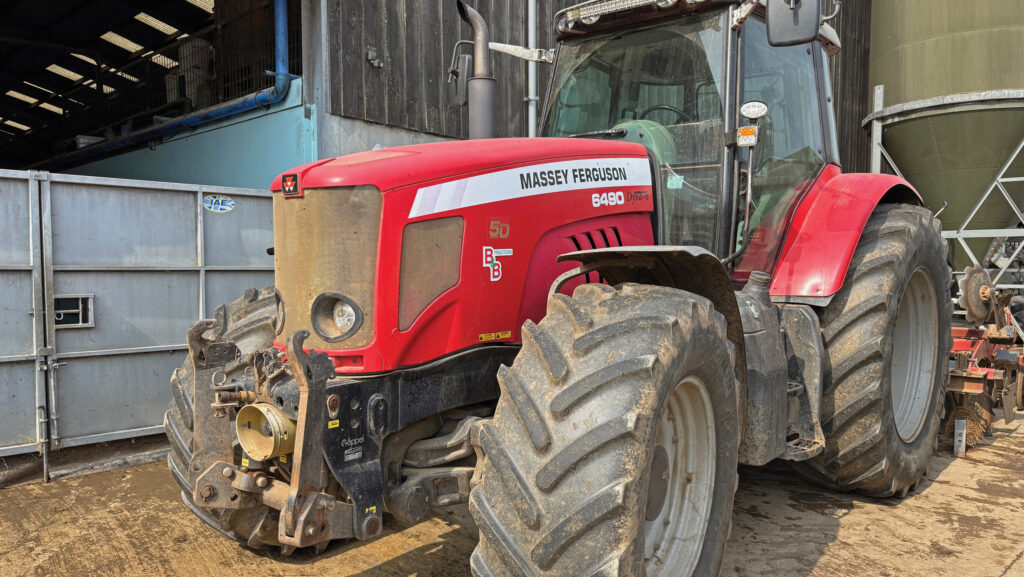
© James Andrews
But a local farmer offered us his in exchange for our 8120 (plus a modest amount of cash), which was too tempting to turn down.
Next on your wish list?
I’m hankering after a big square baler, as that’s one of the few jobs we put out to a contractor.
Modern ones are pricey, so it would likely be an old four stringer with an 80x90cm chamber. Perhaps a Massey Ferguson 185.
I’d love to have a combine too, but that is a hard one to justify for 25ha of barley.
Most embarrassing mistake?
This is more of an amusing story than an embarrassing one.
Our 5475 had been happily tearing around on maize hauling duties all day, but when the engine was stopped, we couldn’t restart it as the electrics were dead.
Where the twin batteries should have been, we found a cluster of hanging wires.
Turns out that the box holding them was a bit ripe and they’d dropped off earlier in the day, unbeknown to the driver, leaving the tractor running off the alternator.
Most expensive repair bill?
If you own a Dyna-6 Massey you’ve got to be prepared to have the synchros done in the range box at some point.
Our 6490 developed the telltale thud when it had done just under 6,000 hours, so we got Chris to split it.
He did the brakes while he was at it and the total bill was about £5,500.
Most overpriced spare part?
The circuit board went wrong on our Lucas G straw chopper and it turned out the part had been discontinued.
This meant we had to buy a whole new electrical assembly, including the joystick, which set us back £1,500.
Best invention?
We’re always making and modifying machines, both to save money and carry out jobs that standard kit can’t do.
None of it looks fancy, as we make use of whatever we’ve got lying around – rusty old bits of shed, shear grab back plates and the like – but it does the job and costs pennies.
Of the lot, the system we came up with for mixing parlour feed has made the biggest impact to our bottom line.
We start off by mixing crimped barley and protein pellets in our back-up Keenan, along with molasses dribbled in from an IBC held above.
This then empties into a hopper above a dosing and blower unit off an old feed lorry, which pushes it into the parlour bin.
By converting the blower drive to pto, we can run it off a tractor and control the flow using a spool valve.
It only cost about £1,000 and saves us £80-£90/t over bought-in alternatives.
Other Carbis creations
Here’s a brief glimpse at a few of the novel implements assembled by Andrew and his dad, Michael.
Kuhn box drill maize conversion
Four 20-litre Roundup cans and a length of four-by-two timber were all that was required to convert the farm’s 3m Kuhn disc box drill into a maize planter.
Each of the containers was cut open at both ends and slotted inside the hopper so that they cover two of the openings.
When these are filled with a mix of seed and starter fertiliser, they allow the drill to plant four double rows of maize.
The area around the containers also has a role to play.
This is filled with compound fertiliser, which is placed between the maize rows using the remaining outlets and coulters.
Cambridge rolls cover crop broadcaster
Fitting a Delimbe pneumatic seeder to a set of 6.3m He-Va Cambridge rolls created a handy tool for reseeding grass and planting herbal leys.
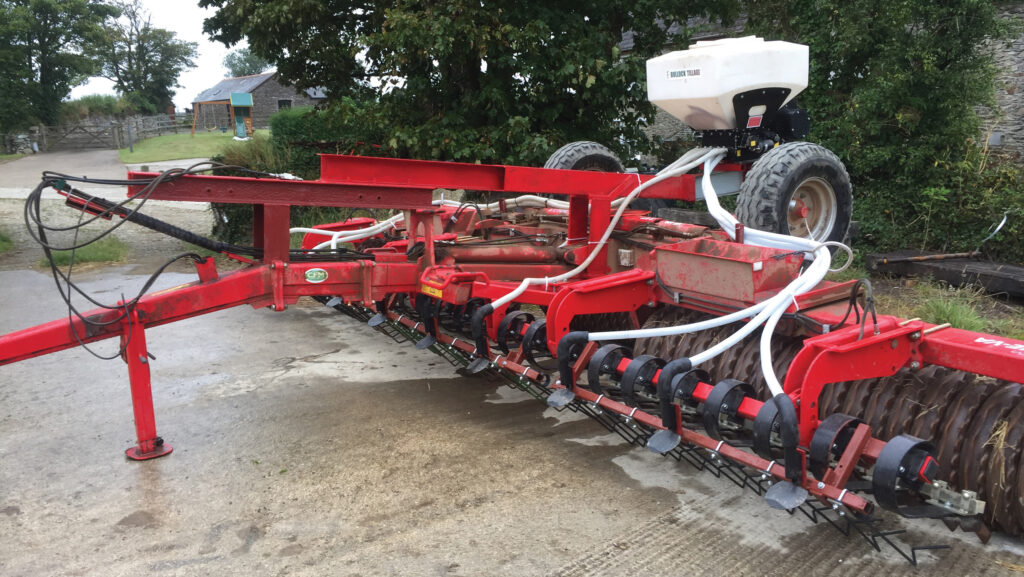
© James Andrews
Front shatter boards were added for levelling worked ground, along with a row of Accord following harrow tines to generate some tilth where soil hasn’t been moved previously.
These also help cover the seed, which is dropped at the front of the machine via a series of spreader plates.
Subsoiling and cultivating toolbars
Versatility of the farm’s Polish-built 3m Dexwall Mamut disc cultivator has been improved thanks to two home-made toolbars.
The lighter-duty one is fitted with a series of straight Vicon tines that help loosen soil down to a few inches.
And when subsoiling needs to be carried out, the tougher version with five Cousins V-form legs and hydraulic depth adjustment steps in.
Ad-lib IBC calf feeders
Andrew’s uncle, David Carbis, came up with a neat design for turning IBCs into ad-lib mobile calf feeders, which are filled using an old modified AG sand dispenser.
These hold a home-made youngstock mix comprising barley, protein pellets, minerals and molasses, which comes in at £210/t.
What couldn’t you live without in the workshop?
We don’t have a fancy workshop, but there are couple of tools that make a big difference when working on projects.
One is the mag drill and the other is our Evolution steel cut-off saw.

© James Andrews
It only cost us about £200, but it’s amazing what it’ll chop through – on one job we were slicing 80mm box section virtually all day.
At £90, the blades are expensive, but they last for ages.
What’s your everyday transport?
I don’t have a pickup or Land Rover. Instead, my farm vehicle is a once bright red, now mostly faded, Skoda Fabia VRS.
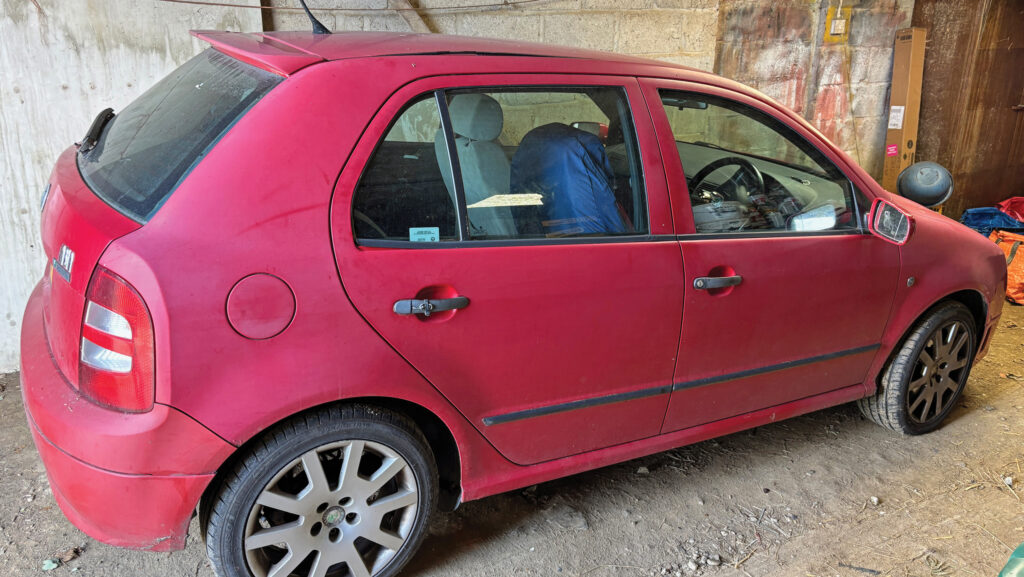
© James Andrews
It’s got a 1.9 TDI engine with PD injection, so it flies and is very good on fuel.
The clock is reading 180,000 miles, but that isn’t that much for one of these engines.
As for Dad, his main runaround is a 25-year-old Yamaha quad bike.
Best tractor you’ve ever had?
The 5475 probably clinches it. We bought it new in 2009 for £31,000 and it’s given us very few problems in 9,300 hours of work.
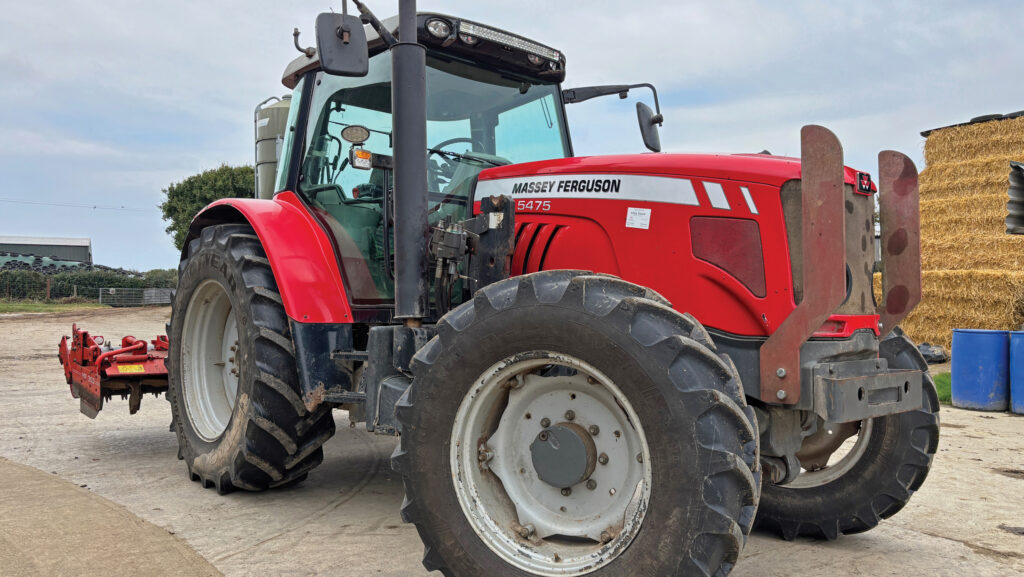
© James Andrews
It’s only supposed to be 135hp, and we haven’t meddled with it, but it’s gutsy enough to pull the forage wagon if we need it to.
And the worst?
A Leyland 804 that was here in the late 1980s. It was constant trouble and both half shafts broke within a few weeks of one another.
When the second one gave out, we replaced it with a Case Maxxum 5120, which was light years ahead.
Most surprisingly useful feature you’ve found on a machine?
We’ve recently bought an RTK GPS setup that can be put on two of the tractors and it’s very handy indeed, particularly for spraying and fertiliser spreading on grass.
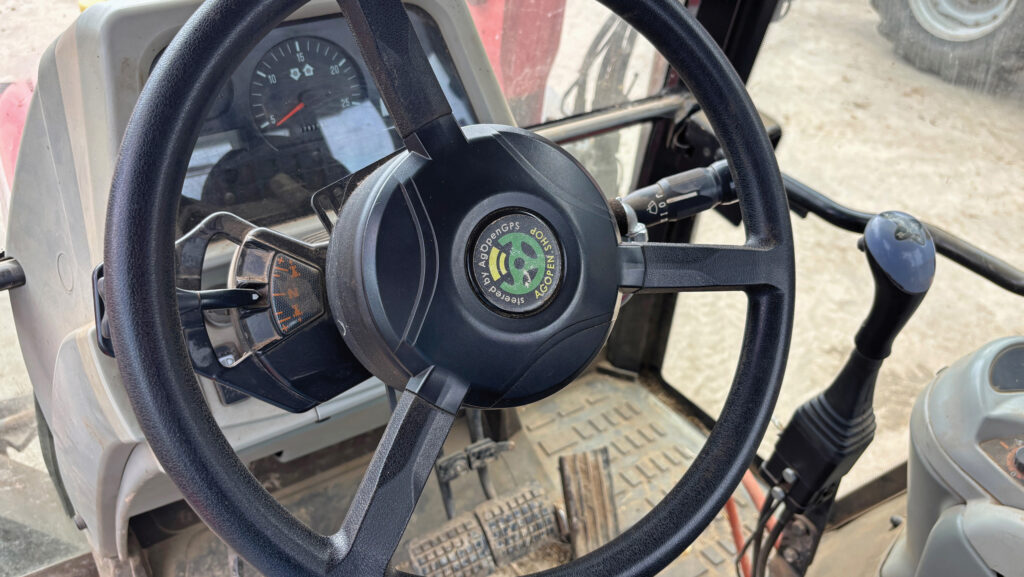
© James Andrews
We were on a budget, so acquired a kit from a Hungarian company called Ag Open.
This runs off free AgOpen GPS software and only cost £1,100, including a steering wheel motor and tablet computer, plus wiring looms and steering angle sensors for two tractors.
It worked brilliantly in the spring, but we’re now having some problems picking up a decent Ntrip correction signal.
The answer might be to install our own base station, although I’m probably going to have to call in some help to get it sorted.
That’s the downside of buying a cheap system from abroad – you’re essentially on your own when it comes to problem solving.
Biggest machinery bargain?
Probably our Teagle RD10 rear-discharge muckspreader.
It had been sitting around in Hamblys’ yard and no one wanted it as it didn’t have a back door, even though it hadn’t done much work.
We weren’t bothered about that, so it seemed a snip at £7,000.
In the shed
- Tractors Massey Ferguson 6490, 6480, 5475, 5455 and 4355; Ford 4600
- Grass Kuhn front and rear mower conditioner, Malone 8.5m tedder, Claas Liner 2900 twin-rotor rake, Strautmann Giga Vitesse 3601 forage wagon
- Cultivators Lemken Europal 6 five-furrow plough, Dexwall Mamut 3m disc harrow with home-made subsoiling and cultivation toolbars, He-Va Cambridge rolls with shatter boards and cover crop broadcasting kit
- Drill 3m Kuhn box drill with home-made dual-row maize conversion
- Telehandler Merlo P 28.7
- Sprayer Jarmet 18m
- Fertiliser spreader Vicon Rotaflow
- Other Keenan mixer wagon x2, McConnel PA6067 hedgecutter, Wakely 0830 roller mill, Bailey 14t and Richard Western 12t grain/silage trailers, Teagle RD10 rear-discharge muckspreader, Major 3,100gal and 2,600gal slurry tankers

